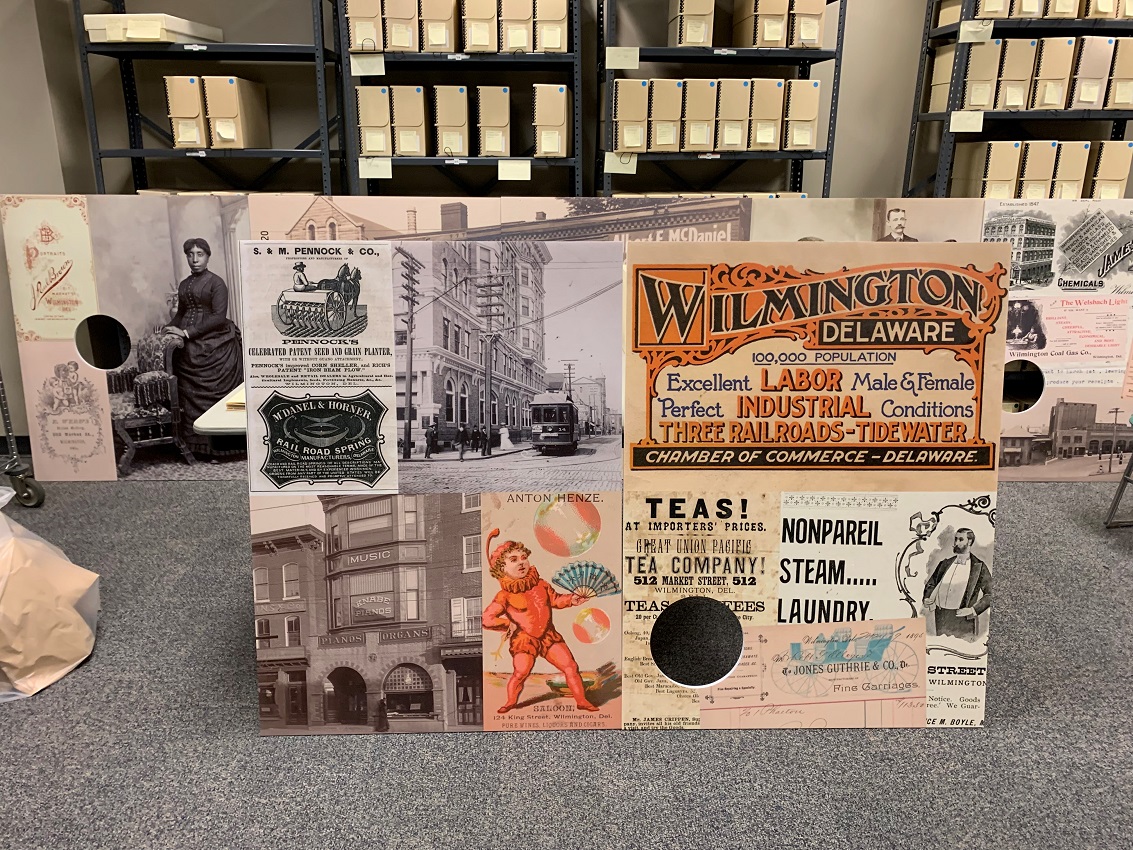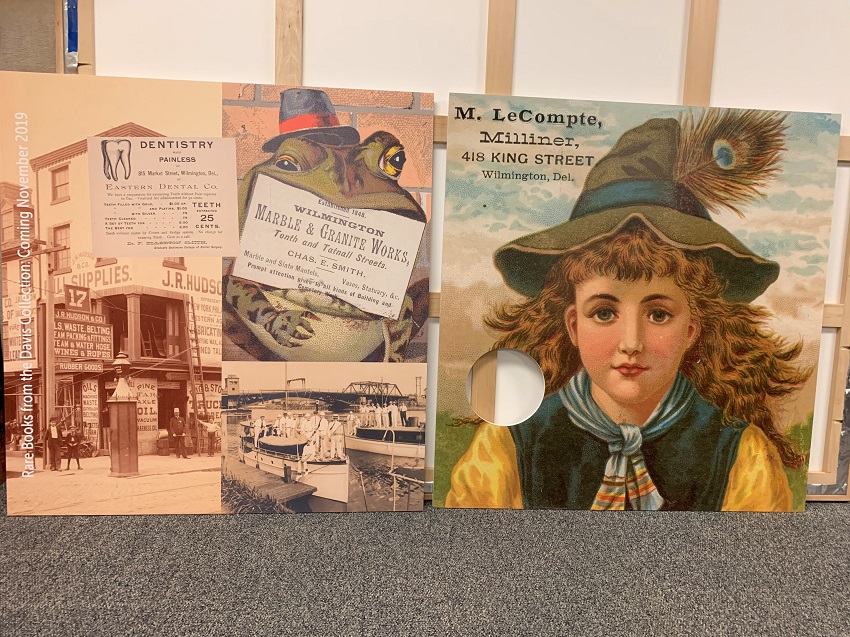October 2019 – In a series of five culminating exhibits, the Delaware Historical Society (DHS) will reveal highlights from the Paul Preston Davis Collection of Delawareana, an important and vast collection of rare business trade cards, photography, African Americana, rare print materials, and commemorative objects.
Mr. Paul Preston Davis, a retired Delmarva Power executive, spent more than four decades collecting the thousands of items he generously donated to DHS in late 2018. Much of “Collecting Wilmington: Place, Perspective & Memory” relates to Wilmington businesses during the nineteenth and early twentieth centuries. The collection covers five specific areas and includes:
- Roughly 12,000 pieces of Wilmington business ephemera (items of collectible memorabilia, usually paper, that were originally expected to have only short-term usefulness or popularity)
- More than 7,000 rare and early photographs, including the works of most major 19th century Wilmington photographers.
- 230 one-of-a-kind objects and artifacts, ranging from small commemorative and promotional items to a box of beautiful 19th century pocket watches from Delaware watchmakers.
- 40 boxes of African Americana from around the state and Civil War Delawareana that will be added to the collection by late 2020.
“The depth and breadth of the collection is stunning, but that is only part of what makes it so unique,” said DHS Chief Curator Leigh Rifenburg. “Mr. Davis cared so deeply for his collection that he took the time to store each item in archival quality materials. Organized and preserved over four decades with the needs of future researchers in mind, the collection represents the dedication of a meticulous collector with a uniquely focused collecting philosophy.”
The collection is important on many levels. It reveals a fascinating and often complex picture of 19th century Wilmington life, including materials from multiple communities, businesses, and social organizations. It highlights businesses owned by women and immigrants, and how gender, race, and ethnicity were represented in early advertising.
So voluminous is the collection, that the DHS will reveal major sections in a series of unveilings at the Delaware History Museum, 504 N. Market St., Wilmington. Each portion of the collection will remain on display as subsequent reveals are held. The dates are as follows:
- Reveal 1: Business Ephemera, October 1, 2019
- Reveal 2: Rare Books and Print Materials, November 14, 2019
- Reveal 3: Sheet Music, January 14, 2020
- Reveal 4: Watches and Commemorative Objects, March 3, 2020
- Reveal 5: Wilmington Photography, May 6, 2020
The vast collection fills notable gaps in DHS existing collections, said Rifenburg. For instance, until now, there were only three known tintype images of African Americans in the DHS image collection. The Davis Collection includes an entire album.
While cause for celebration, the massive collection required six staff members, one moving van, 75 crates, and 3,000 feet of bubble wrap to pack and transport to its new, permanent home at DHS.
Mr. Davis’s collecting journey began at age nine with an unusual gift…an 18th century ledger from Philadelphia passed down by his aunt. Even as he collected comic books and baseball cards with his friends, Davis recognized the ledger’s significance. Later, while serving in the Coast Guard during the Korean War, he gravitated to book shops and flea markets during his days off in port. Back in Delaware, his collecting began in earnest with a focus on children’s books and materials related to famed illustrator Howard Pyle.
During the 1960s, while rising through the ranks at Delmarva Power, Davis shifted his energies to focus on Wilmington business ephemera. He often traveled to Lancaster, PA, a regional hub for paper collecting, and developed relationships with dealers throughout the Delaware Valley. Over the next four decades, he built a collection of ephemera that reveals the development of Wilmington during the 19th and early 20th centuries.
In conjunction with the exhibits, the Delaware Historical Society has planned evening programs to explore segments of the collection, with hands-on activities that relate to the collection. Additional programs will be announced at a later date. Scheduled programs include:
- Art in Advertising: Business Ephemera
With the development of chromolithography and the ability to reproduce multicolor artwork quickly and inexpensively, the late 19th century saw an emergence of trade cards as a form of advertising. This collection of a wide variety of trade cards exemplifies the enthusiasm with which Wilmington businesses embraced this popular form of marketing. What can trade cards tell us about life in Wilmington during the 19th century? Join us as we explore Wilmington business history and reimagine trade cards for the 21st century.
October 1, 6 p.m., $5 to cover cost of materials.
- The Process of Preservation: Rare Books
In 1761 printer James Adams, set up shop in Delaware and printed his first four items – two books, a pamphlet, and a broadside. Examples of Adams’ work in this collection can tell us much about technology, print culture, business and industry, and the dissemination of information in Wilmington during the early republic. Join Book Restorer and Conservation Technician, Domonique Alesi for a talk about the importance and process of preserving rare books. Hands-on demonstration included.
Domonique Alesi attended the University of the Arts, where she studied Illustration and Book Arts and learned artistic bindings and techniques. She has also apprenticed under David Donahue of David Donahue Book Restoration Studio in Philadelphia.
November 14, 6 p.m., $5 to cover cost of materials.
Reservations for evening programs are requested, but not required. To register for the October 1, 2019 event, please call (302) 656-0637 or email Siri Nesheim at snesheim@dehistory.org. The Delaware History Museum is open Wednesdays through Saturdays, 11 a.m. to 4 p.m






